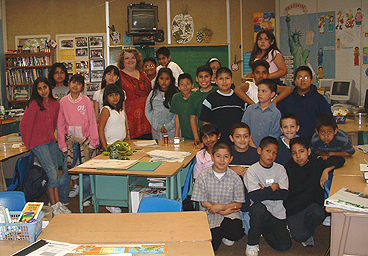|
Mrs. Benson’s Class Experiment Page
Spider Contests

Mrs. Benson's 5th grade class
Introduction: Most species of spiders are solitary, territorial predators. Web-builders use webs as a means to capture prey. Building a web demands energy (in the form of silk) and spiders that build webs invest that energy to gain access to food, which is necessary for growth and reproduction.
Territorial spiders defend a certain area as their territory; this can be just their web and sometimes extends to an area beyond their web. In confrontations between two spiders, the owner of the web generally fights more for it, because she put the energy into building it. Size can also affect the outcome of an encounter between two spiders. For example, in a battle between a large and small spider, the large spider may be more likely to win.

Students introduce spiders to a web in the plastic container
Hypotheses: In this experiment we had two hypotheses:
1) Because a web is of value to a spider and spiders are solitary (they do not share webs), we hypothesize that when two spiders find a vacant web, they will fight for it, and one of them will win and take over the web.
2) When the two spiders fight over the web, we expect the larger spider to win, and remain on the web.

Transporting spiders to the web
Materials and Methods: We used funnel web spiders (Hololena tentativa) in both parts of our experiment.
For the first part of the experiment we wanted to see if spiders fight over a web. We put one spider in a container to build a web and then removed it. Then we put two different spiders in the container with the vacant web (neither of the two introduced spiders was a resident).
In the second part, we wanted to see if larger spiders were more likely to win the contest than small spiders. The paired spiders were divided into two groups. In the experimental group, the two spiders had different weights. In the control group the two spiders had a similar weight. Having a control group allows us to identify other factors (not related to the difference in weight between spiders) that could affect our results. We had six pairs of spiders in the experimental group and three pairs in the control group. Previous to pairing the control and experimental spiders, we weighed each spider and marked one of the spiders in the group with non-toxic paint. This allowed us to identify the spiders later (otherwise they would all look the same). All the spiders we used were juveniles. As soon as we put the two spiders in the container with the web we made observations for 15 minutes. After a day, we observed who was holding the web and declared that spider the winner.

Preparing to weigh the spiders
Results: In the experimental group, the larger spider won twice, both spiders were on the web three times, and once the web was vacant. In the control group, the web was vacant once, and the other two times one spider was on the web.
Conclusions: The results were not exactly as expected. The smaller spider never won and the larger spider won twice. These results give some support to the hypothesis that states that the larger spider is more likely to win. Therefore, spider weight seems to have an effect on the outcome of the contests.
The fact that in both groups (control and experimental) there were vacant webs, seems to indicate that the webs were probably not of high value to the spiders. We noticed that some of the webs did not have much silk and did not cover the entire area of the container. So, the quality or value of the web might have affected our results. |

